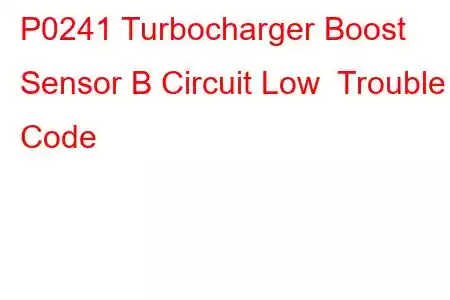P0241 Turbocharger/Supercharger Boost Sensor B Circuit Low
OBD-II Trouble Code Technical Description
Generic: Turbocharger/Supercharger Boost Sensor "B" Circuit Low
What does that mean?
This is a generic powertrain diagnostic trouble code (DTC) applicable to all turbocharged or supercharged vehicles. Brands may include but are not limited to Audi, Nissan, Mitsubishi, Mazda, VW etc.
The powertrain control module (PCM) monitors boost pressure with a sensor called the manifold absolute pressure sensor (MAP). Understanding how a MAP sensor works is the first step in explaining the cause of P0241.
The PCM sends a 5 volt reference signal to the MAP sensor and the MAP sensor sends a variable voltage signal back to the PCM. When boost pressure is high the voltage signal is high. When boost pressure is low the voltage is low. The PCM uses the boost control solenoid to control the amount of boost pressure that is produce by the turbocharger while at the same time using the boost pressure sensor to verify that the boost pressure is correct.
This code sets when the PCM senses a low voltage signal indicating low boost pressure when a high pressure command has been sent to the boost control solenoid "B".
Symptoms
Symptoms of a P0241 code may include:
Check engine light will be on Low engine power Reduced fuel economyBecause of the increased chance of catalytic converter damage and turbo over boost when P0241 is present it should be corrected before continuing to use the vehicle.
Causes
Potential causes for this code to set are:
Faulty boost sensor "B" Faulty turbocharger Faulty PCM Wiring problemDiagnostic and Repair Procedures
Before diagnosing P0241 be sure there are no other trouble codes present in the PCM memory. If there are other DTC’s present, they should be checked first. Any codes related to waste gate control or 5 volt reference will induce the conditions necessary to set this code. In my experience the PCM is the least likely cause of this problem. More often than not it is chafed or burnt wiring near the turbocharger causing shorts or opens in the circuit.
A good starting point is always to check for technical service bulletins (TSB) for your particular vehicle. Your issue may be a known issue with a known fix put out by the manufacturer and can save you time and money during diagnosis.
A thorough visual inspection is critical when trying to solve this particular DTC. I have seen Faulty connections or faulty wiring be the root of the problem more than anything else. Disconnect the connectors at the boost sensor "B" and boost control solenoid "B" and look carefully at the contact terminals (the metal parts inside the plastic plug) for evidence of spreading. Using silicone dielectric compound on all connections when reassembling. Turn the ignition key on with engine off (KOEO) back probe the boost sensor reference wire at the sensor connector with a digital volt ohm meter (DVOM) check for 5 volts. If voltage is correct back probe the boost sensor signal wire should between .2 volts and .5 volts. If correct go to next step, if not suspect a faulty boost sensor. Leave DVOM connect and start the engine and using a hand held vacuum pump apply vacuum to the turbocharger waste gate vacuum motor. The voltage should increase, if it does suspect a faulty PCM, if it does not, suspect a faulty turbocharger.Read: 36


